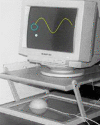Visuo-motor coordination deficits and motor impairments in Parkinson's disease
- PMID: 18987752
- PMCID: PMC2576439
- DOI: 10.1371/journal.pone.0003663
Visuo-motor coordination deficits and motor impairments in Parkinson's disease
Abstract
Background: Visuo-motor coordination (VMC) requires normal cognitive executive functionality, an ability to transform visual inputs into movement plans and motor-execution skills, all of which are known to be impaired in Parkinson's disease (PD). Not surprisingly, a VMC deficit in PD is well documented. Still, it is not known how this deficit relates to motor symptoms that are assessed routinely in the neurological clinic. Such relationship should reveal how particular motor dysfunctions combine with cognitive and sensory-motor impairments to produce a complex behavioral disability.
Methods and findings: Thirty nine early/moderate PD patients were routinely evaluated, including motor Unified Parkinson's Disease Rating Scale (UPDRS) based assessment, A VMC testing battery in which the subjects had to track a target moving on screen along 3 different paths, and to freely trace these paths followed. Detailed kinematic analysis of tracking/tracing performance was done. Statistical analysis of the correlations between measures depicting various aspects of VMC control and UPDRS items was performed. The VMC measures which correlated most strongly with clinical symptoms represent the ability to organize tracking movements and program their direction, rather than measures representing motor-execution skills of the hand. The strong correlations of these VMC measures with total UPDRS score were weakened when the UPDRS hand-motor part was considered specifically, and were insignificant in relation to tremor of the hand. In contrast, all correlations of VMC measures with the gait/posture part of the UPDRS were found to be strongest.
Conclusions: Our apparently counterintuitive findings suggest that the VMC deficit pertains more strongly to a PD related change in cognitive-executive control, than to a reduction in motor capabilities. The recently demonstrated relationship between gait/posture impairment and a cognitive decline, as found in PD, concords with this suggestion and may explain the strong correlation between VMC dysfunction and gait/posture impairment. Accordingly, we propose that what appears to reflect a motor deficit in fact represents a multisystem failure, dominated by a cognitive decline.
Conflict of interest statement
Figures




Similar articles
-
Subthalamic nucleus deep brain stimulation does not improve visuo-motor impairment in Parkinson's disease.PLoS One. 2013 Jun 11;8(6):e65270. doi: 10.1371/journal.pone.0065270. Print 2013. PLoS One. 2013. PMID: 23776460 Free PMC article. Clinical Trial.
-
The effects of gait impairment with and without freezing of gait in Parkinson's disease.Parkinsonism Relat Disord. 2012 Mar;18(3):239-42. doi: 10.1016/j.parkreldis.2011.10.008. Epub 2011 Nov 13. Parkinsonism Relat Disord. 2012. PMID: 22079524
-
Global cognitive function and processing speed are associated with gait and balance dysfunction in Parkinson's disease.J Neuroeng Rehabil. 2016 Oct 28;13(1):94. doi: 10.1186/s12984-016-0205-y. J Neuroeng Rehabil. 2016. PMID: 27793167 Free PMC article.
-
Gait in Parkinson's disease: A visuo-cognitive challenge.Neurosci Biobehav Rev. 2016 Mar;62:76-88. doi: 10.1016/j.neubiorev.2016.01.002. Epub 2016 Jan 7. Neurosci Biobehav Rev. 2016. PMID: 26773722 Review.
-
Bilateral contemporaneous posteroventral pallidotomy for the treatment of Parkinson's disease: neuropsychological and neurological side effects. Report of four cases and review of the literature.J Neurosurg. 1999 Aug;91(2):313-21. doi: 10.3171/jns.1999.91.2.0313. J Neurosurg. 1999. PMID: 10433321 Review.
Cited by
-
Altered perceptual sensitivity to kinematic invariants in Parkinson's disease.PLoS One. 2012;7(2):e30369. doi: 10.1371/journal.pone.0030369. Epub 2012 Feb 17. PLoS One. 2012. PMID: 22363430 Free PMC article.
-
Neuroprotective effects of Eucommia ulmoides Oliv. and its bioactive constituent work via ameliorating the ubiquitin-proteasome system.BMC Complement Altern Med. 2015 May 21;15:151. doi: 10.1186/s12906-015-0675-7. BMC Complement Altern Med. 2015. PMID: 25994206 Free PMC article.
-
Using Probabilistic Movement Primitives in Analyzing Human Motion Differences Under Transcranial Current Stimulation.Front Robot AI. 2021 Sep 14;8:721890. doi: 10.3389/frobt.2021.721890. eCollection 2021. Front Robot AI. 2021. PMID: 34595209 Free PMC article.
-
Test-Retest Reliability of Measures Commonly Used to Measure Striatal Dysfunction across Multiple Testing Sessions: A Longitudinal Study.Front Psychol. 2018 Jan 12;8:2363. doi: 10.3389/fpsyg.2017.02363. eCollection 2017. Front Psychol. 2018. PMID: 29375455 Free PMC article.
-
The difference in visuomotor feedback velocity control during spiral drawing between Parkinson's disease and essential tremor.Neurol Sci. 2018 Jun;39(6):1057-1063. doi: 10.1007/s10072-018-3331-4. Epub 2018 Mar 23. Neurol Sci. 2018. PMID: 29572654
References
-
- Flowers K. Some frequency response characteristics of parkinsonism on pursuit tracking. Brain. 1978a;101:19–34. - PubMed
-
- Flowers K. Lack of prediction in the motor behaviour of parkinsonism. Brain. 1978b;101:35–52. - PubMed
-
- Levin BE, Llabre MM, Reisman S, Weiner WJ, Sanchez-Ramos J, et al. Visuospatial impairment in Parkinson's disease. Neurology. 1991;41:365–369. - PubMed
MeSH terms
LinkOut - more resources
Full Text Sources
Other Literature Sources
Medical

